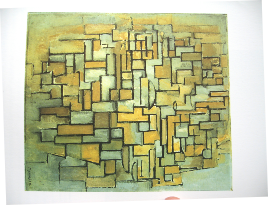





Mondrian seems to have spent his whole life drawing short black lines trying to find out why certain lines look good and others not so good as above. He is reported to have known about the Golden Proportion but made no claims that it influenced his work in any way. Looking at his extensive work on lines, it is clear that he was experimenting with what looked good. He went through many changes in style and retrospectively one can trace the dramatic evolution of his experiments in his early work with different line lengths and their positioning. He saw that certain line relationships looked better than others and constantly varied the arrangement to find what the best looked. In his later work we appreciate and enjoy a most beautiful balanced and dramatic painting. Gone are all the apparent immature fumbling lines. He never explained what he was searching for and neither what he found and neither described what the main features of his beautiful rectangles were. We as analytical scientists come along and reveal that he as an artist he included abundant Golden Proportions. We all have a strong sense of the Golden Proportion, but not only don’t we realise it but we don’t even realise how frequently, we naturally use it. Even our own ordinary handwriting is full of Golden Proportions. Every time we decorate a cake or make a flower arrangement, we unknowingly balance our design with the Golden Proportion Not, surprisingly one can detect many Golden Proportion relation ships between the searching lines in Mondrian’s early work, but they are nothing in comparison to the bold and beautiful rectangles drawn later. No wonder the Tate was willing to pay £2.8 million for Mondrian’s “Composition” with Red 1935 causing a public outcry. My letter published in the Evening Standard pg. 28 Dec 8 1999 however, encouraged the purchase.
